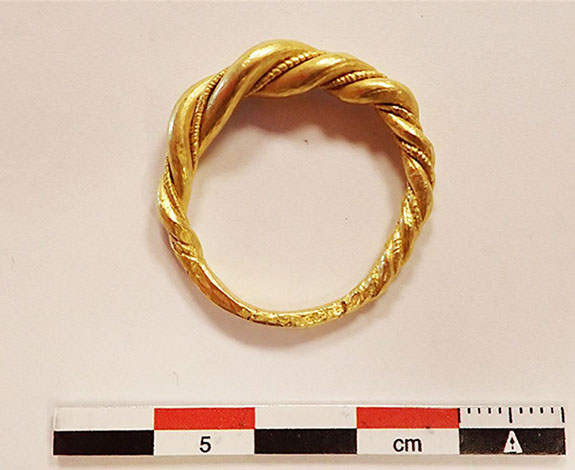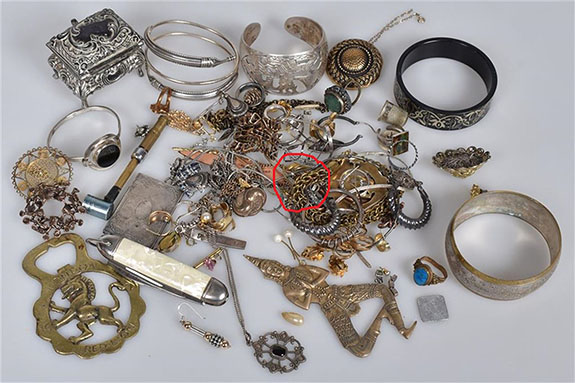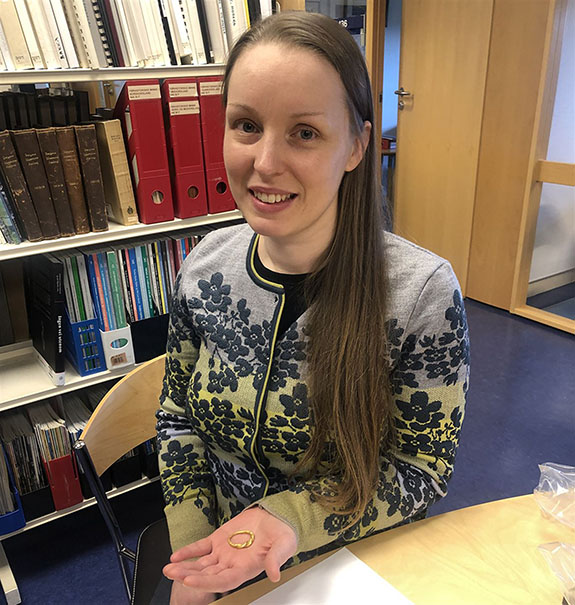July 12th, 2022
It's not every day that a rare solid gold artifact from the Late Iron Age turns up in a package of costume jewelry, but that's the exact scenario a young Norwegian woman faced when she got a lot more than she paid for at an online auction site.

After previewing pics of the site's offerings, Mari Ingelin Heskestad honed in on a bold, twist-motif gold-colored ring.
“It was really heavy, and shiny. It looked very special,” Heskestad told Bergensavisen, BA, a Norwegian newspaper.

Heskestad wasn't allowed to purchase the single ring, which was part of a grouping of 50-plus items. Instead, she had to bid on the complete lot — a mixed bag of low-value, non-precious earrings, bracelets, pendants, brooches and rings. Also thrown into the lot was a pocket-knife, pill box, pipe and other trinkets.
When the package arrived, the gold ring turned out to be even more special than Heskestad expected.

Her father-in-law, who has some experience with historical artifacts, suspected that the ring might be from the Scandinavian Viking Age and advised Heskestad to contact the Vestland County archaeological team.
Karoline Hareide Breivik, acting section leader for cultural heritage in Vestland County, was able to quickly confirm that Heskestad's gold ring was, indeed, from the Late Iron Age/Viking Age, which dates between 400 AD and 800 AD.
Breivik said that rings with this twist motif have been found in Norway in the past, but they were mostly made from silver.
“Gold was rare during the Viking Age," Unn Pedersen, an associate professor of archaeology at the University of Oslo, told Science Norway. "So this would have been reserved for the richest and most powerful people in society.”
Based on its size and weight (11 grams or 0.4 ounces), the gold ring was likely worn by a male of high social and economic status, perhaps a Viking chief, reported Science Norway.
Archeologists are often frustrated when there is no way to track the precise origin of an artifact. The Viking ring couldn't be tracked to a particular place or person because it was one of many jewelry items from an unnamed estate that had been randomly packed into banana crates and shipped to the auction site for liquidation.
Heskestad wasn't permitted to keep the ring because of its historical nature. Instead, it will have a new home at Norway's University Museum in Bergen, where it will make its public debut in the fall of 2022.
Credits: Images courtesy of Vestland County Municipality.

After previewing pics of the site's offerings, Mari Ingelin Heskestad honed in on a bold, twist-motif gold-colored ring.
“It was really heavy, and shiny. It looked very special,” Heskestad told Bergensavisen, BA, a Norwegian newspaper.

Heskestad wasn't allowed to purchase the single ring, which was part of a grouping of 50-plus items. Instead, she had to bid on the complete lot — a mixed bag of low-value, non-precious earrings, bracelets, pendants, brooches and rings. Also thrown into the lot was a pocket-knife, pill box, pipe and other trinkets.
When the package arrived, the gold ring turned out to be even more special than Heskestad expected.

Her father-in-law, who has some experience with historical artifacts, suspected that the ring might be from the Scandinavian Viking Age and advised Heskestad to contact the Vestland County archaeological team.
Karoline Hareide Breivik, acting section leader for cultural heritage in Vestland County, was able to quickly confirm that Heskestad's gold ring was, indeed, from the Late Iron Age/Viking Age, which dates between 400 AD and 800 AD.
Breivik said that rings with this twist motif have been found in Norway in the past, but they were mostly made from silver.
“Gold was rare during the Viking Age," Unn Pedersen, an associate professor of archaeology at the University of Oslo, told Science Norway. "So this would have been reserved for the richest and most powerful people in society.”
Based on its size and weight (11 grams or 0.4 ounces), the gold ring was likely worn by a male of high social and economic status, perhaps a Viking chief, reported Science Norway.
Archeologists are often frustrated when there is no way to track the precise origin of an artifact. The Viking ring couldn't be tracked to a particular place or person because it was one of many jewelry items from an unnamed estate that had been randomly packed into banana crates and shipped to the auction site for liquidation.
Heskestad wasn't permitted to keep the ring because of its historical nature. Instead, it will have a new home at Norway's University Museum in Bergen, where it will make its public debut in the fall of 2022.
Credits: Images courtesy of Vestland County Municipality.


